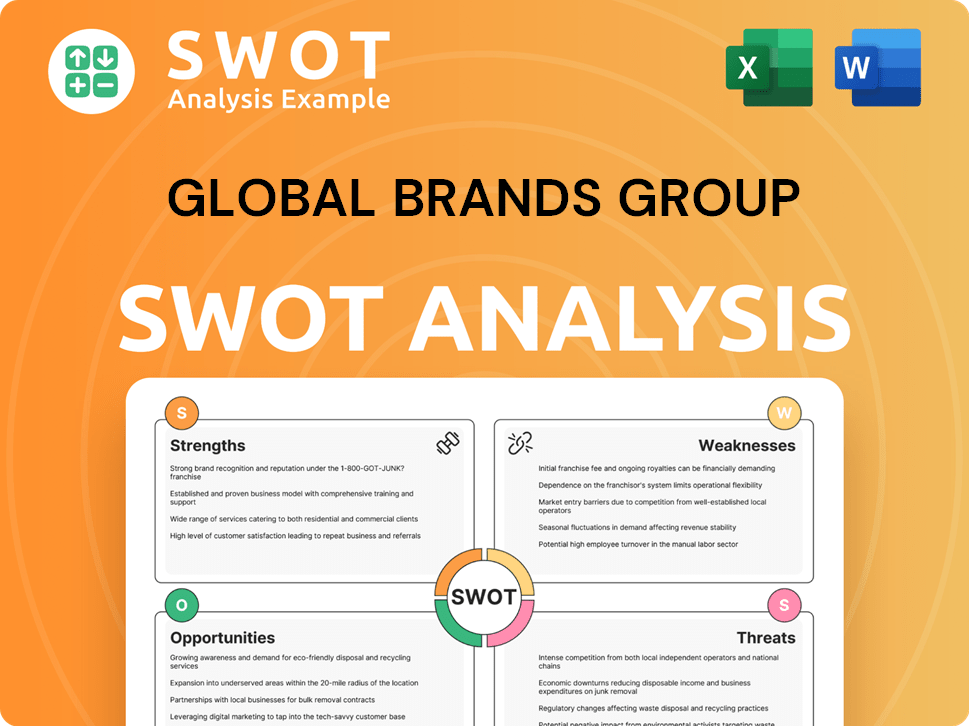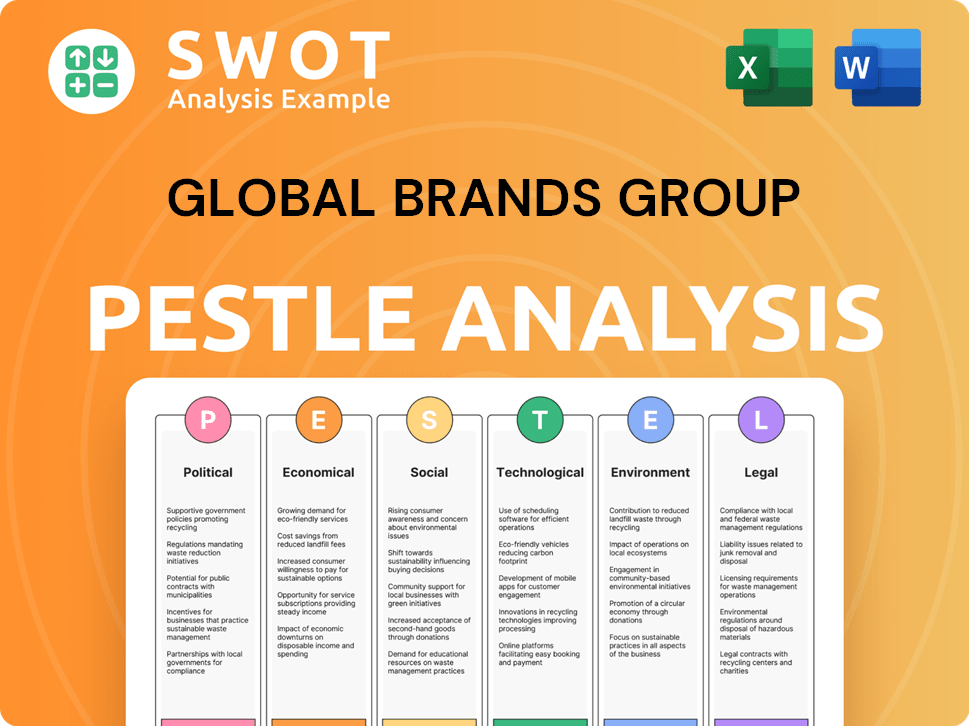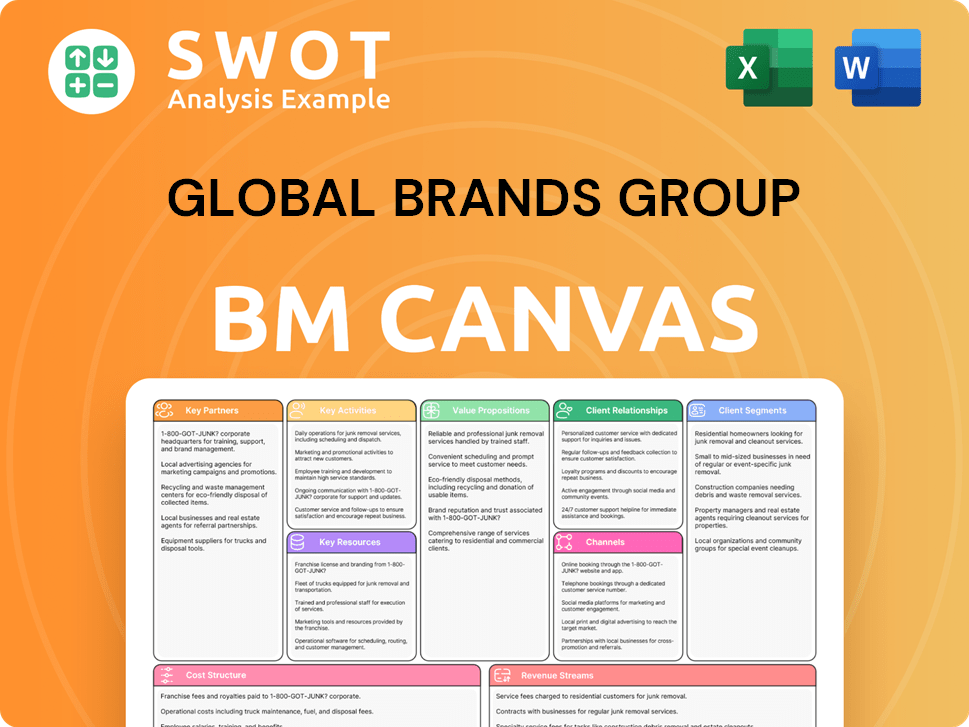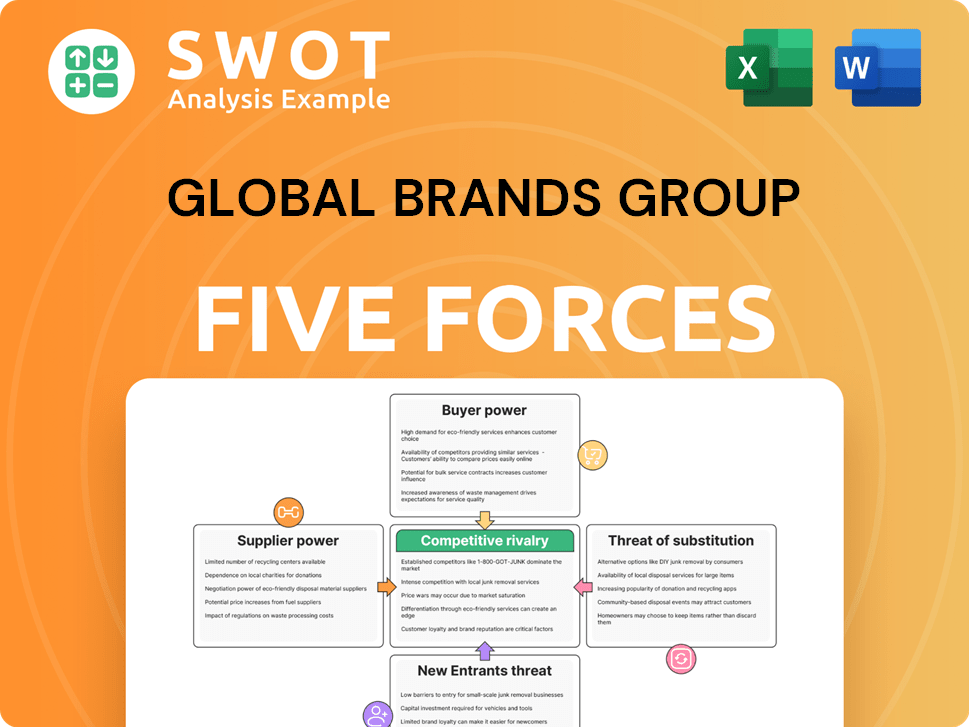Global Brands Group Bundle
What Went Wrong with Global Brands Group's Sales and Marketing?
Global Brands Group (GBG), once a fashion powerhouse, offers a compelling case study in the volatile world of retail. From its inception in 2005, the company aimed to dominate the apparel and accessories market, but ultimately faced liquidation. This in-depth analysis dives into the Global Brands Group SWOT Analysis, exploring the sales and marketing strategies that defined its rise and, ultimately, contributed to its fall.

Understanding GBG's approach to brand management, international marketing, and retail strategy provides crucial insights for today's businesses. We'll dissect its GBG marketing campaigns, sales strategy for international expansion, and digital marketing initiatives. This exploration of Global Brands Group's business model and competitive analysis offers valuable lessons on sales and marketing trends in the fashion industry, and how to improve sales in the fashion industry.
How Does Global Brands Group Reach Its Customers?
The sales and marketing strategy of Global Brands Group (GBG) relied on a multi-channel approach to reach a wide customer base. This involved a combination of online and offline sales avenues, reflecting a comprehensive retail strategy. The company's primary focus was wholesale, with a history of supplying private label and branded apparel to retailers.
Over time, GBG strategically invested in direct-to-consumer (DTC) retail, indicating an evolution in its customer engagement methods. This shift included the launch of specialized e-commerce platforms. The company's geographical operations were primarily in North America and Europe, with North America being the largest revenue generator.
Key to GBG's growth were strategic partnerships and exclusive distribution deals. A significant example is the joint venture with Creative Artists Agency (CAA-GBG Global Brand Management Group), which became the world's largest brand management company, extending brands into new product categories and regions. This partnership, established in 2016, managed celebrity brands such as David Beckham and Drew Barrymore, along with major brands like Coca-Cola and Crayola.
GBG utilized a mix of online and offline channels. These included department stores, hypermarkets, off-price retailers, independent chains, specialty retailers, and e-commerce platforms. This multi-faceted approach allowed GBG to reach a broad audience and cater to diverse consumer preferences.
The company's roots were in wholesale, supplying retailers with private label and branded apparel. There was a strategic move towards direct-to-consumer (DTC) retail. This shift was evident with the launch of specialized e-commerce platforms, allowing for direct customer engagement.
GBG's operations were primarily concentrated in North America and Europe. North America was the largest revenue generator for the company. This geographical focus allowed GBG to tailor its sales and marketing efforts.
Partnerships were crucial for GBG's growth. The joint venture with CAA-GBG Global Brand Management Group was a significant move. This partnership expanded brand reach across new product categories and geographies.
GBG's sales and marketing strategy involved a blend of wholesale and direct-to-consumer approaches, supported by strategic partnerships. The focus on both online and offline channels allowed for a broad market reach. The company's international marketing efforts were centered in North America and Europe.
- Multi-Channel Distribution: Leveraging department stores, hypermarkets, off-price retailers, independent chains, specialty retailers, and e-commerce.
- DTC Expansion: Investing in direct-to-consumer retail to enhance customer engagement.
- Strategic Partnerships: Collaborating with entities like CAA-GBG to extend brand reach.
- Geographical Focus: Prioritizing North America and Europe for sales and marketing efforts.
Global Brands Group SWOT Analysis
- Complete SWOT Breakdown
- Fully Customizable
- Editable in Excel & Word
- Professional Formatting
- Investor-Ready Format

What Marketing Tactics Does Global Brands Group Use?
The marketing tactics employed by Global Brands Group (GBG) historically focused on building brand awareness, generating leads, and driving sales across its diverse portfolio. These strategies were tailored to the specific needs of each licensed and private label brand within its portfolio. While specific details on recent (2024-2025) marketing initiatives are limited due to the company's liquidation, the company did leverage technology and data-driven approaches.
GBG's approach to sales and marketing strategy involved a combination of digital and traditional methods. The company utilized a tech stack including Amazon Web Services and Google Analytics, indicating a focus on digital marketing tactics such as content marketing, SEO, and paid advertising. The brand management segment provided comprehensive services from creative inspiration to product launches.
Before its liquidation, Global Brands Group aimed to improve operational efficiencies through restructuring, which included streamlining processes and moving functions offshore. This suggests an effort to optimize marketing spend and improve overall marketing effectiveness. The company's focus on data-driven decision-making and operational efficiency was crucial for navigating the competitive landscape of the fashion and apparel industries.
GBG's digital marketing efforts likely included content marketing, SEO, and paid advertising to reach online consumers. The use of Google Analytics suggests a focus on data-driven optimization of these campaigns. This approach is typical for fashion brands aiming to increase online visibility and sales.
The brand management segment offered services such as creative inspiration, market targeting, and product development. This comprehensive approach ensured that marketing efforts were aligned with brand identity and consumer preferences. This is a key component of a successful Growth Strategy of Global Brands Group.
GBG's use of tools like Google Analytics indicates a data-driven approach to understanding customer segments and tailoring marketing efforts. This focus on data is essential for optimizing marketing spend and improving ROI. Data-driven marketing is a key trend in the fashion industry.
The restructuring program aimed to improve operating efficiencies, including streamlining processes from design to sourcing. This would have helped improve the effectiveness of marketing campaigns. Efficiency is critical in the competitive fashion market.
GBG's international presence likely involved adapting marketing strategies to suit different regional markets. This includes localization of content and campaigns. International marketing requires a deep understanding of local consumer preferences.
GBG's retail strategy would have involved a mix of online and offline channels to reach consumers. This could include partnerships with retailers and e-commerce platforms. Retail strategy is key for sales in the fashion industry.
GBG's marketing tactics likely involved a mix of digital and traditional methods, with a focus on data-driven decision-making. The company's brand management services provided comprehensive support, from creative inspiration to product launches. The restructuring program aimed to improve operational efficiencies, including streamlining processes from design to sourcing.
- Digital Marketing: Content marketing, SEO, and paid advertising.
- Brand Management: Creative inspiration, market targeting, and product development.
- Data Analysis: Utilizing tools like Google Analytics to understand customer segments.
- Operational Efficiency: Streamlining processes to improve marketing effectiveness.
Global Brands Group PESTLE Analysis
- Covers All 6 PESTLE Categories
- No Research Needed – Save Hours of Work
- Built by Experts, Trusted by Consultants
- Instant Download, Ready to Use
- 100% Editable, Fully Customizable

How Is Global Brands Group Positioned in the Market?
The brand positioning of Global Brands Group (GBG) focused on being a leading player in the fashion industry, specializing in branded fashion accessories, footwear, and apparel. This positioning was built on a diverse portfolio of owned and licensed brands, allowing GBG to cater to a wide range of consumer preferences and market segments. Their core strategy revolved around designing, developing, marketing, and selling products across various categories, including kidswear, men's and women's fashion, and brand management.
GBG's approach to brand management was crucial, as it aimed to elevate both licensed and owned brands. This involved expanding their category penetration and global reach through innovative design, strong brand management, and a clear strategic vision. The company's success was dependent on its ability to consistently deliver high-quality products and maintain a strong brand image across all channels.
GBG's brand portfolio included well-known names such as Calvin Klein and Juicy Couture, along with brands associated with celebrities. This diverse mix allowed GBG to appeal to a broad audience, encompassing both established fashion credibility and popular lifestyle trends. The company's brand management arm, CAA-GBG, further solidified its position by increasing the perceived value of product lines and brands over time. This focus on brand value and consistent messaging was key to their Growth Strategy of Global Brands Group.
GBG managed a diverse portfolio, including brands like Calvin Klein and Joe's Jeans. This variety allowed the company to target different consumer segments and fashion trends. The ability to manage both licensed and owned brands was a key aspect of their business model.
GBG's target audience encompassed a broad demographic. Their brand selection, including collaborations with celebrities, aimed to capture both mainstream and niche consumer preferences. This wide appeal was a core element of their GBG marketing strategy.
A strong emphasis on brand management was central to GBG's strategy. This involved consistent messaging and maintaining brand value across all touchpoints. CAA-GBG played a crucial role in enhancing the perceived value of product lines.
GBG's brand positioning supported international expansion. Their diverse brand portfolio and effective sales and marketing strategy facilitated global reach. This approach was critical for their growth.
GBG's brand positioning was built on several key elements that contributed to its success. These included a diverse brand portfolio, a focus on brand management, and a clear strategy for international marketing.
- Diverse Brand Portfolio: Offering a wide range of brands to cater to different consumer segments.
- Brand Management: Ensuring consistent messaging and enhancing brand value.
- International Marketing: Expanding global reach through strategic sales and marketing.
- Category Penetration: Increasing market share through innovative design and strategic vision.
Global Brands Group Business Model Canvas
- Complete 9-Block Business Model Canvas
- Effortlessly Communicate Your Business Strategy
- Investor-Ready BMC Format
- 100% Editable and Customizable
- Clear and Structured Layout

What Are Global Brands Group’s Most Notable Campaigns?
Given the operational status of Global Brands Group Holding Limited, specific details on large-scale sales and marketing campaigns from 2024-2025 are limited. Historically, the company focused on driving growth and brand visibility through various initiatives. These campaigns reflected its diverse brand portfolio and aimed to reach a wide consumer base.
One notable aspect of the company's strategy was the launch of Juniper Unlimited, an inclusive e-commerce marketplace. This initiative demonstrated a commitment to innovative marketing by entering the adaptive space. Such campaigns were designed to expand market reach and cater to specific consumer segments, highlighting a focus on inclusivity.
Collaborations with influencers and partners were also a key part of the sales and marketing strategy. The joint venture, CAA-GBG, played a significant role in brand management, working with celebrity brands to boost brand awareness and engagement. These partnerships were designed to extend brand assets into new product categories and geographies, ultimately aiming to increase sales and market share.
The company utilized brand management strategies, particularly through CAA-GBG. This involved collaborations with celebrity brands like David Beckham and Drew Barrymore. The aim was to leverage their influence to enhance brand awareness and consumer engagement, a strategy common in the fashion and apparel industries.
GBG likely employed digital marketing initiatives to reach consumers. This would include social media campaigns, targeted advertising, and content marketing. These efforts would be crucial for driving online sales and maintaining a strong brand presence in the competitive market.
The company focused on international marketing, likely adapting strategies to different regional markets. This would involve understanding local consumer preferences and tailoring campaigns accordingly. This approach is critical for expanding the brand's global footprint and increasing sales.
Retail strategy would have been a key focus, involving decisions about distribution channels and partnerships with retailers. This strategy would have been essential for maximizing product visibility and accessibility to consumers, which is a crucial element of the company's sales and marketing strategy.
Global Brands Group Porter's Five Forces Analysis
- Covers All 5 Competitive Forces in Detail
- Structured for Consultants, Students, and Founders
- 100% Editable in Microsoft Word & Excel
- Instant Digital Download – Use Immediately
- Compatible with Mac & PC – Fully Unlocked

Related Blogs
- What are Mission Vision & Core Values of Global Brands Group Company?
- What is Competitive Landscape of Global Brands Group Company?
- What is Growth Strategy and Future Prospects of Global Brands Group Company?
- How Does Global Brands Group Company Work?
- What is Brief History of Global Brands Group Company?
- Who Owns Global Brands Group Company?
- What is Customer Demographics and Target Market of Global Brands Group Company?
Disclaimer
All information, articles, and product details provided on this website are for general informational and educational purposes only. We do not claim any ownership over, nor do we intend to infringe upon, any trademarks, copyrights, logos, brand names, or other intellectual property mentioned or depicted on this site. Such intellectual property remains the property of its respective owners, and any references here are made solely for identification or informational purposes, without implying any affiliation, endorsement, or partnership.
We make no representations or warranties, express or implied, regarding the accuracy, completeness, or suitability of any content or products presented. Nothing on this website should be construed as legal, tax, investment, financial, medical, or other professional advice. In addition, no part of this site—including articles or product references—constitutes a solicitation, recommendation, endorsement, advertisement, or offer to buy or sell any securities, franchises, or other financial instruments, particularly in jurisdictions where such activity would be unlawful.
All content is of a general nature and may not address the specific circumstances of any individual or entity. It is not a substitute for professional advice or services. Any actions you take based on the information provided here are strictly at your own risk. You accept full responsibility for any decisions or outcomes arising from your use of this website and agree to release us from any liability in connection with your use of, or reliance upon, the content or products found herein.